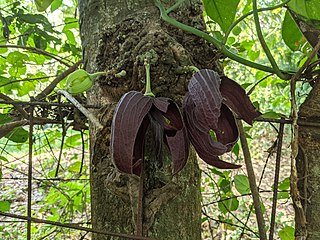Maquenque Wildlife Refuge, is a protected area in Costa Rica, managed under the Arenal Huetar Norte Conservation Area, it was created in 2005 by decree 32405-MINAE.

Copaifera is a genus of tropical plants in the legume family Fabaceae. It includes 40 species native to the tropical Americas, west and central tropical Africa, and Borneo.

Garcinia aristata is a species of flowering plant in the family Clusiaceae. It is native to Cuba, and possibly Hispaniola and Puerto Rico. It is threatened by habitat loss.
Athyana is a monospecific genus of plant in the family Sapindaceae, containing only Athyana weinmannifolia. It is found in Argentina and Bolivia. It is threatened by habitat loss.
Gentianella crassulifolia is a species of flowering plant in the family Gentianaceae.

Gentianella hirculus is a species of flowering plant in the family Gentianaceae. It is endemic to Ecuador. Its natural habitats are subtropical or tropical high-altitude shrubland and subtropical or tropical high-altitude grassland.
Loxopterygium grisebachii is a species of plant in the family Anacardiaceae. It is found in Argentina and Bolivia. It is threatened by habitat loss.
Macrocarpaea thamnoides is a species of plant in the family Gentianaceae. It is endemic to Jamaica. It is threatened by habitat loss.
Tabebuia bibracteolata is a species of flowering plant in the family Bignoniaceae. It is endemic to Cuba.
Tabernaemontana wullschlaegelii is a species of flowering plant in the family Apocynaceae. It is endemic to Jamaica.
Amauroclopius ornatus is an assassin bug that is thought to prey upon bees. A. ornatus is associated with the cativo tree of Colombia.

Prioria is a genus of flowering plants in the family Fabaceae. Members of this genus are found in Central America, Africa, southern Asia, and Oceania.
Racinaea spiculosa is a species of flowering plant in the family Bromeliaceae. This species is native to Bolivia, Brazil, Costa Rica, Venezuela and Ecuador.
Vriesea incurva is a plant species of flowering plant in the family Bromeliaceae. This species is an epiphyte native to Central America, the Greater Antilles, and South America.
Werauhia ringens is a species of flowering plant in the family Bromeliaceae. This species is native to Costa Rica and Ecuador.
Clusia clusioides is species of flowering plant in the family Clusiaceae. It is a small tree which that is native to Puerto Rico and Hispaniola. One characteristic are the opposite, very thick leaves. It is very common in the dwarf or elfin forests at elevations above c. 2,500 feet (760 m), in particular in areas with much light. The gray and smooth bark of the tree is sometimes covered with mosses and other epiphytes including orchids.
Carmenta surinamensis is a moth of the family Sesiidae. It was described by Heinrich Benno Möschler in 1878, and is known from Brazil, Suriname, Guyana, Trinidad, Panama and Costa Rica. The larvae of the species have been found on seeds of the plant Prioria copaifera, Pentaclethra macroloba, and plants in the genus Mora.
Dioscorea trilinguis it is a species of flowering plant in the family Dioscoreaceae. It is a climbing tuberous geophyte that is native to southeastern Brazil, and is found growing in tropical forests, dry forests, and on clay soil.

Sapranthus palanga, commonly known as palanca, is a species of cauliflorous tree in the family Annonaceae, native to the tropical regions of Central America, especially Costa Rica.

Hoppea fastigiata is a species of herbaceous plant in the family Gentianaceae. It is a small branched herb with oppositely arranged ovate, subsessile leaves. White flowers appear in terminal or axillary cymes. Flowering and fruiting season is September-October.







